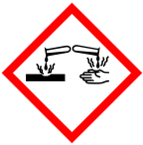 Chemical containers must meet the labeling requirements of the Global Harmonization Standard (GHS). GHS hazard information, including pictograms and hazard warnings, are necessary to ensure that both lab personnel and non-lab personnel are aware of the physical and/or health hazards of the chemical. The hazard warnings may be communicated through pictures, symbols, words, or a combination of each. Labs may use lab tape and write the hazards that apply to the solutions. Labs may also download the Global Harmonization (GHS) pictograms template and print labels for any working containers.
Chemical containers must meet the labeling requirements of the Global Harmonization Standard (GHS). GHS hazard information, including pictograms and hazard warnings, are necessary to ensure that both lab personnel and non-lab personnel are aware of the physical and/or health hazards of the chemical. The hazard warnings may be communicated through pictures, symbols, words, or a combination of each. Labs may use lab tape and write the hazards that apply to the solutions. Labs may also download the Global Harmonization (GHS) pictograms template and print labels for any working containers.
Labs must ensure that the hazard labels are present on all hazardous chemicals that are stored or used. There are two types of labels that must meet the expectations of GHS.
- Manufacturer’s labels (labels on chemical containers purchased from a vendor) must meet the following requirements:
- The name of the chemical and the hazards of the chemical must be present on the label.
- The label must be legible.
- The label must be written in English.
- The label cannot be defaced, marked out, or removed until the original contents are removed from the container.
- Working containers or portable secondary containers must also meet the requirements of OSHA’s Hazard Communication Standard. The label on the working containers of hazardous chemicals must contain:
- The identity of the chemical (e.g. chemical name).
- The hazards associated with the chemical.
Leave a Reply